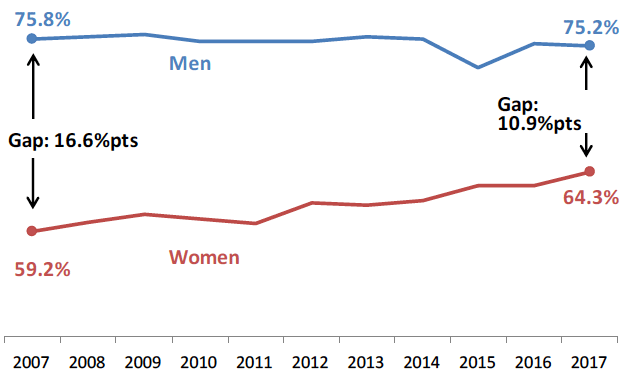5. Motor Vehicles, Traffic And Driving
5. Motor Vehicles, Traffic And Driving
This section contains analysis and headline findings from the Scottish Household Survey questions on driving and car access (including the Travel Diary part of the survey), as well as comparisons with data from a range of other sources.
Driving Licences
Seventy per cent of the population (17+) had a driving licence in 2017, an increase compared with 67% in 2007. [Table SUM1 and Table 1]
Men were more likely to hold a driving than women, with three quarters (75%) of men aged 17+ having a driving licence, compared to 64 per cent of women. There has been a narrowing of this gap over the years of the survey. [Table 1 and Figure 1]
Figure 1: Percentage of people aged over 17 who hold a driving licence, 2007-2017

Driving licence possession was lowest amongst the youngest and oldest age groups (17-19: 31% and 80+: 47%) and highest amongst those aged 40-49 and 50-59 (both 81%). [Table 1]
Driving licence possession increased with net annual household income (44% for adults in households with less than £10,000 of income compared to 89% in households with an income over £40,000). [Table 19]
Driving licence possession is more common in rural areas (61% of adults in large urban areas have a driving licence, compared to 83% of those in accessible or remote rural areas). [Table 19]
Car And Van Access
Seventy two per cent of households had access to one or more cars or vans for private use in 2017. Twenty nine per cent of households had access to two or more cars (or vans). [Tables 18 & SUM1]
Car access increases with household income, as does the number of cars available per household: six per cent of households with an annual income up to £10,000 had access to two or more cars, compared to sixty six per cent of households with an annual income of more than £40,000. [Table 18]
Households in rural areas were more likely to have access to a car than those in urban areas, and households in rural areas were also more likely to have access to more than one car than households in urban areas. [Table 18]
Frequency Of Driving
Sixty three per cent of those aged 17+ drove at least once a week in 2017, with 42 per cent driving every day. [Tables 20 & SUM1]
Frequency of driving was higher in rural areas and increased with income. Thirty two per cent of adults in large urban areas drove every day compared to 54% in accessible rural areas and 50% in remote rural areas. Sixteen per cent of adults living in households with a total annual income of under £10,000 drove every day, compared to sixty three per cent of those who lived in households with a total annual income of over £40,000. [Table 20]
Car Occupancy
The average car occupancy was 1.5 people in 2016; the rate has remained similar in recent years. The proportion of single occupancy journeys was around two thirds (66%) of car journeys in 2017. This is similar to the figure for 2017, following a generally increasing trend from 2007. [Table TD9]
Fuel Spend
The average amount which households spent on fuel in the last month rose slightly between 2016 and 2017, from £105.60 to £107.00. The median figure remains at £80. [Table 2]
Licenced Vehicles
Licensed Vehicles
There were 250,000 new vehicles registered in Scotland in 2017, compared to 270,000 registrations in 2016. [Table SUM2]
The number of vehicles licensed for use on the roads increased by 1.4 per cent from 2.92 million to 2.96 million between 2016 and 2017. [Table SUM2]
More detailed statistics on vehicles licensed in Scotland can be found in the Road Transport Vehicles Chapter of Scottish Transport Statistics.
Road Network
There are 56,364 km of road in Scotland. Of this, 6.5 per cent (3,681 km) is Trunk road, the remaining 52,684 km are managed by Local Authorities. [Table SUM2]
More detailed statistics on the road network in Scotland can be found in the Road Network chapter of Scottish Transport Statistics.
Road Traffic
The estimated volume of traffic on Scotland’s roads was at its highest ever level - 48 billion vehicle kilometres in 2017, an increase on 46.5 billion in 2016. [Table SUM2]
More detailed statistics on road traffic in Scotland can be found in the Road Traffic chapter of Scottish Transport Statistics.
Reported Road Casualties
Provisional figures show a total of 9,391 road casualties reported to the police in 2017 (14%, fewer than in 2016). Of these, there were 146 fatalities; 45 (24%) fewer than in 2016. There were 1,580 serious injuries; 119 (7%) fewer than in 2016 and 7,665 slightly injured; 1,350 (15%) fewer than in 2016.
All these 2017 road casualty figures are the lowest since annual records began in 1950. More detailed statistics can be found in Key Reported Road Casualties.
Electric Vehicles
The proportion of people saying they owned an electric car or van in 2017 was 0.7%, compared with 0.3% in 2016. Forty one per cent of respondents said they would consider buying an electric car or van compared to 36% in 2016. [Table 49]
Of the people who had bought or would consider buying a plug-in electric car or vehicle, the main reasons were their environmentally friendliness (70%) and their fuel or running costs (63%). [Table 50] For those who said they would not consider buying an electric vehicle, the distance that could be travelled on a single charge (45%) and the availability or convenience of charging points (also 45%) were the main deterrents. [Table 51]